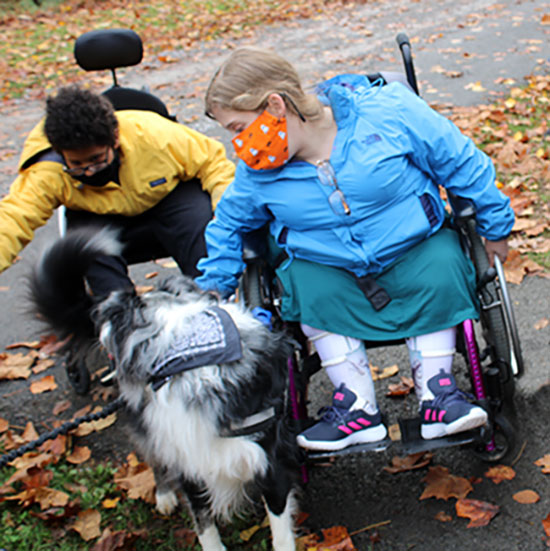
WHAT IS SPINA BIFIDA?
Spina bifida is an abnormality of the nervous system that occurs in a baby’s development during the first month of pregnancy. Most textbooks define spina bifida as a neural tube defect or a gap in the fusing of the neural tube that encloses the spinal cord.
While a neural tube defect indicates a diagnosis of spina bifida, it is only part of what is a total nervous system disorder. The number of children born with spina bifida is approximately 1 in every 1,500 births. There are three main types of Spina Bifida. The most common are:
- Myelomeningocele
A sac containing an abnormally formed spinal cord protrudes from an opening in a baby’s back. The nerves at and below the defect are damaged. The higher the defect occurs on the spine, the greater the number of nerves that are affected. Babies need surgery shortly after birth to repair the affected area of the back. - Meningocele
A baby is born with a sac protruding from an opening in the back. Unlike with Myelomeningocele, the sac doesn’t contain the spinal cord. Most often, few nerves are affected. Babies need surgery shortly after birth to repair the affected area of the back. - Spina Bifida Occulta
In Spina Bifida Occulta, the bones around a baby’s spinal cord fail to develop normally. The nerves of the spinal cord usually are normal, as is the skin on the back. Sometimes, however, there will be a dimple, hair patch or red discoloration on the skin at the point of the defect. Babies rarely need surgery shortly after birth to repair the defect.
Life Expectancy
Historically, a child born with a more serious form of spina bifida or more severe neural tube defect was expected to live a greatly abbreviated life. Today, however, increased education about spina bifida, emphasis on the importance of personal care, greater understanding of the accompanying health issues associated with the condition, as well as surgical advances have resulted in a much higher quality of life and greater life expectancy for persons with spina bifida. As many as 90 percent of persons born with spina bifida will survive into and possibly past their third decade of life. The current adult population living with spina bifida is reaching unprecedented levels of achievement.

Folic Acid and Spina Bifida
Folic acid, a B vitamin, has been found to play an important role in reducing the incidence of spina bifida. The U.S. Department of Health and Human Services’ Center for Disease Control recommends that all women of child bearing age consume 400 mcg of folic acid per day. It is important to note, however, that taking a folic acid supplement, or consuming the equivalent of 400 mcg of folic acid in the diet, is not a guarantee against a child being born with spina bifida. Folic acid cannot “cure” spina bifida; rather, it can help reduce the chances of a child developing the condition in utero.
Why me/my child?
Most parents, when learning of a diagnosis of spina bifida, wonder if they did something to cause their child to have this condition. Nothing a parent does or does not do results in a child being born with spina bifida. There is no known cause of spina bifida.
What happens now?
When a baby is diagnosed with spina bifida, the course of action a doctor may recommend depends entirely on the type of spina bifida and the location of the defect in relation to the baby’s spine.
In children born with Myelomeningocele, surgery is performed shortly after birth to repair the abnormality and prevent further damage to the spinal cord and nerves. During surgery, the opening in the baby’s back is sewn closed. The surgery does not bring back function, but serves to prevent further injury and infection. Because this opening is now closed, there is no way for cerebral spinal fluid (CSF) to drain and a condition called Hydrocephalus can occur. Hydrocephalus, commonly referred to as “water on the brain,” is an abnormal accumulation of CSF within cavities inside the brain. It occurs when there is an imbalance between the amount of CSF that is produced and the rate at which it is absorbed. As the CSF builds up, it causes the cavities, also called ventricles, to enlarge and the pressure inside the head to increase. Surgery is performed to put a shunt in place that will allow this fluid to drain and maintain an appropriate amount of intracranial pressure. A shunt is a flexible tube placed into the ventricular system that diverts the flow of CSF into another region of the body where it can be absorbed.
Babies born with Meningocele also require surgery to close the opening in the back. Since the sac does not contain the spinal cord, the rest of the central nervous system is generally not involved and prognosis for development is excellent.
Spina Bifida Occulta occurs in as many as 20-30% of the population and often is not diagnosed until adulthood. Oftentimes patients are seen for back pain, enuresis and scoliosis – to discover through x-rays of the spine that they have spina bifida occulta. This type of spina bifida results in the least frequency of impairment.
In recent years, surgeons have begun to perform prenatal, intrauterine surgical repairs on the fetus to correct an abnormality. Intrauterine surgical repair reduces the baby’s risk of contracting infection because the sac containing spinal cord tissue is no longer exposed to bacteria upon birth. This type of surgery is not without risks to both mother and baby, however, and the benefits must be carefully weighed against the risks.
While surgery will close the opening in the baby’s back and prevent infection, the damage caused as a result of the nerves being exposed during the baby’s development cannot be repaired.


